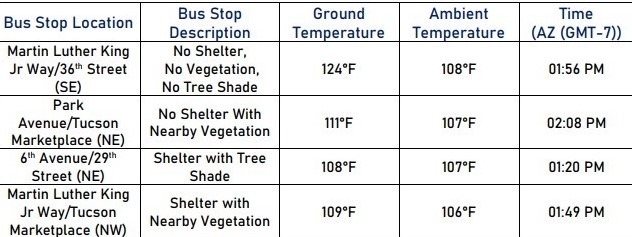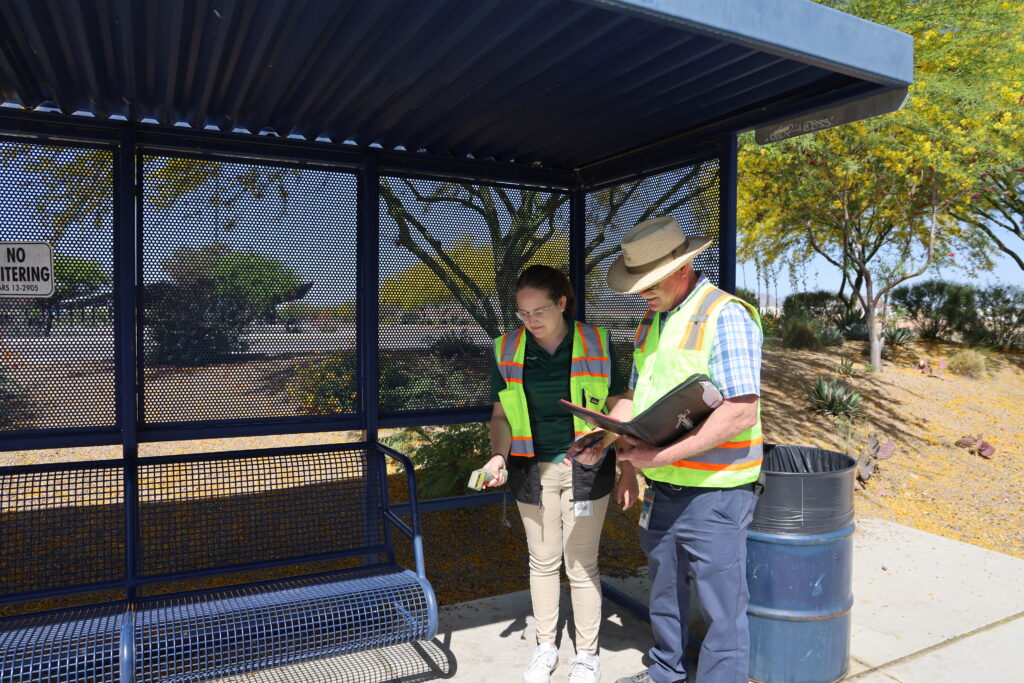Finding Ways to Best Reduce Heat Stress at Bus Stops
May 8, 2024Ever felt like a melted popsicle waiting for the bus? Sun Tran dove into a cool study to figure out how to beat the heat at bus stops.
While Tucson is located in the hottest desert, it is also an urban area that is suffering from the Urban Heat Island effect. Structures in the built environment generally absorb and re-emit heat than natural structures. July 2023 was Tucson’s hottest month on record and hit triple-digit temperature highs each day. The increase in extreme heat is escalating and can only be expected to become more devastating each year.
On average, Sun Tran has over 51,000 daily riders, each one waiting at a bus stop. When physical bus shelters are not available, riders rely on nearby vegetation for relief from the sun. Vegetation surrounding each bus stop varies but it is alarmingly scarce along major roadway corridors and newly developed lands.
On August 4, 2023, Sun Tran staff visited multiple bus stops throughout the City of Tucson and measured both ambient and ground temperatures. By gathering this data at varying bus stops, Sun Tran staff were able to identify the amenities that best reduces heat. Bus stops that have vegetation nearby were found to have lower ambient air temperatures than bus stops without vegetation. The presence of a bus stop shelter notably reduces the ground temperature, but it was also equally as effective in cooling the ambient air.

The results found in this study have been used to develop an ‘ideal bus stop’ project and have been incorporated into grant applications. The most notable to date is the Tucson Resilient Together Bus Stop Enhancement project. Six bus stops have been selected to receive Tucson Resilient Together improvements based on a tiered system.
Tier 1: Bus stops will receive shelters, static information displays, benches, solar powered lighting and a tamper-proof trash receptacle.
Tier 2: Bus stops will receive the same amenities as Tier 1, in addition to native vegetation, green storm water infrastructure, dynamic information kiosk, emergency call button and security cameras.
Tier 3: Bus stops will receive all the same amenities as Tier 2, with a bike-share station.
Sun Tran staff continues to look for methods and green infrastructures, while repairing and maintaining what is already in use. It is important to note that not all bus stops are eligible for enhance amenities due to Public Right of Way, but these bus stops still need solutions for extreme heat conditions.

It is necessary for future research projects on hear resiliency at bus stops to be conducted to supplement Sun Tran’s findings. After the Tucson Resilient Together Bus Stop Enhancement project, Sun Tran staff plan to conduct a similar study to ensure that the solutions identified by this study are functioning to reduce heat.
All future Sun Tran bus stop enhancement projects will incorporate this study’s findings into their design, with an emphasis on native vegetation plantings. Sun Tran hopes to continue to improve its bus stops and the experience for riders.